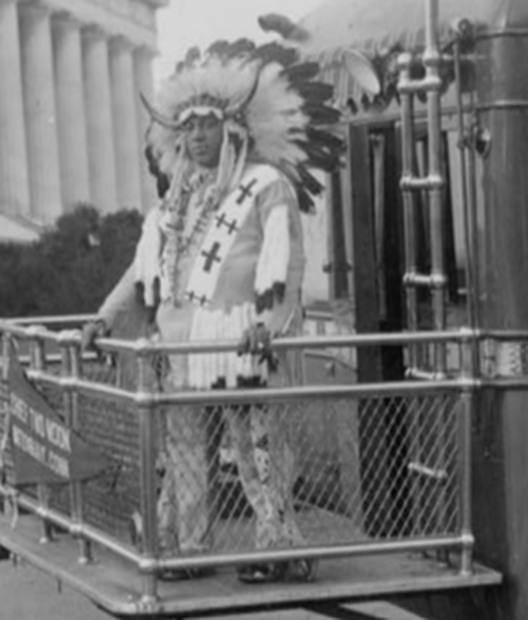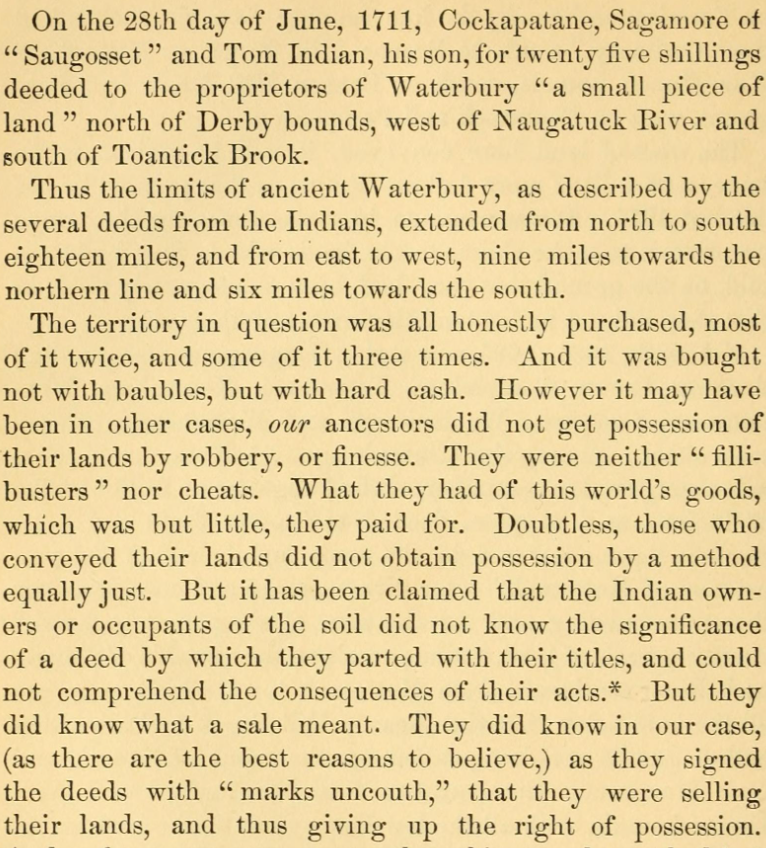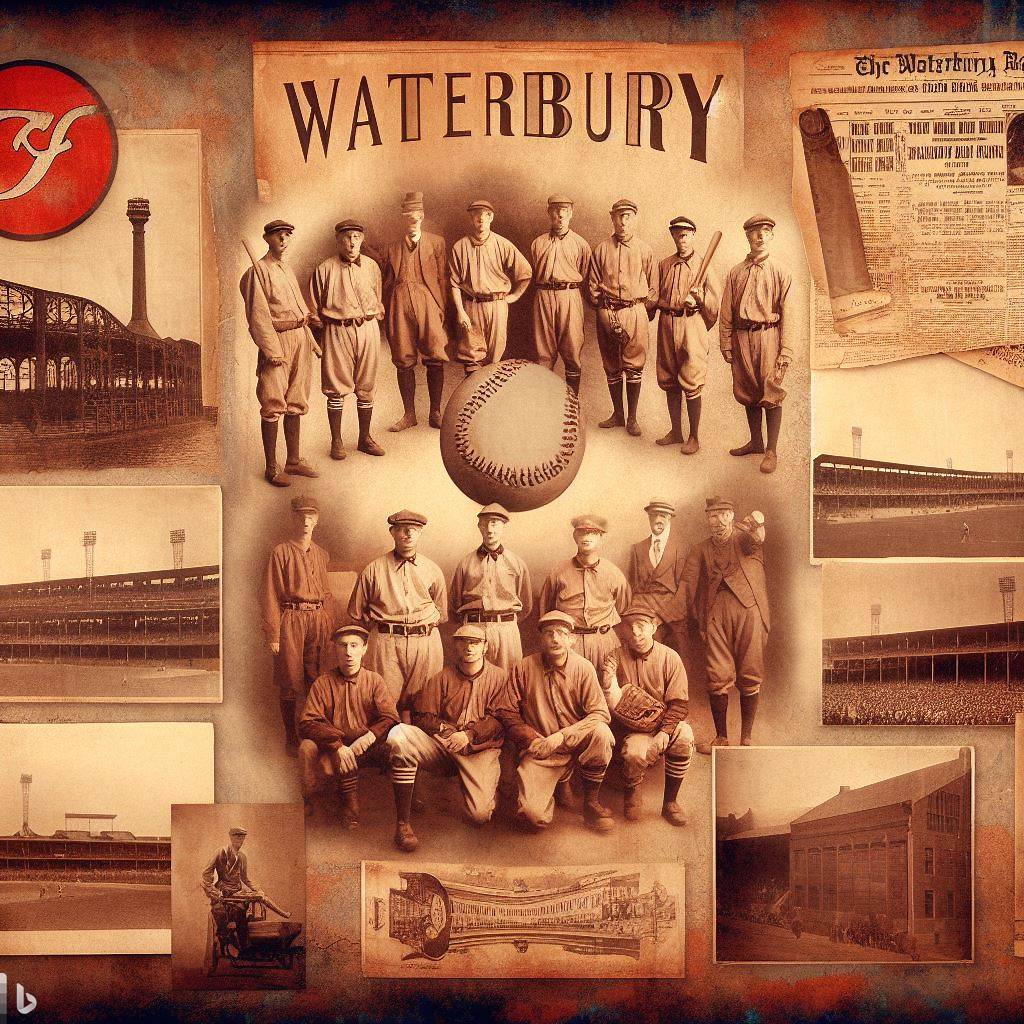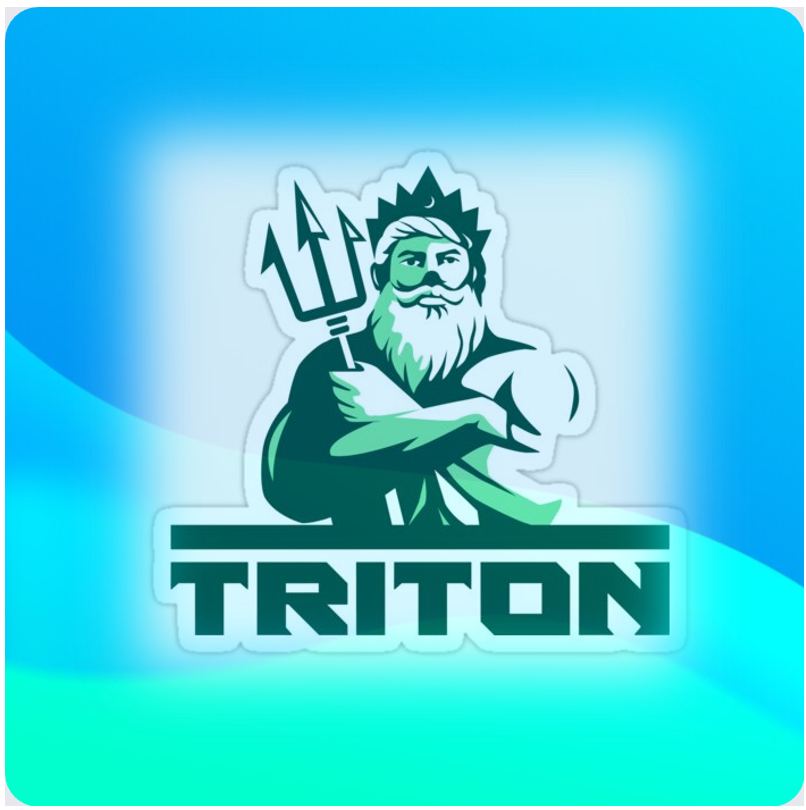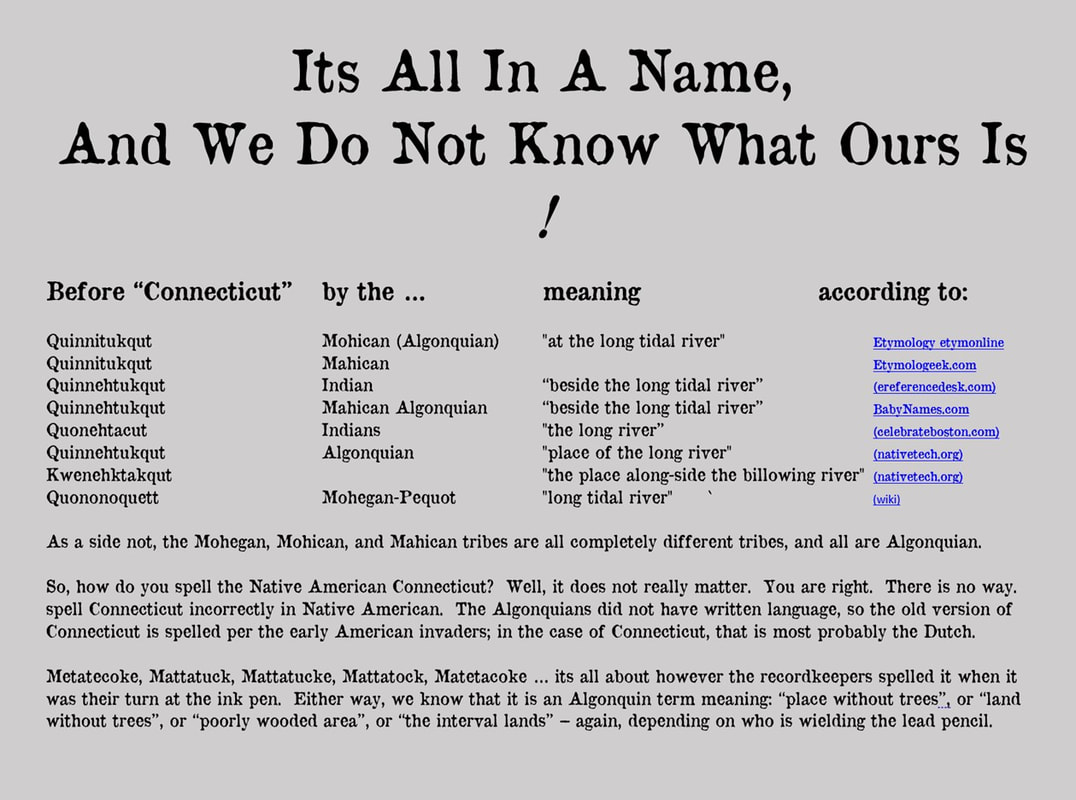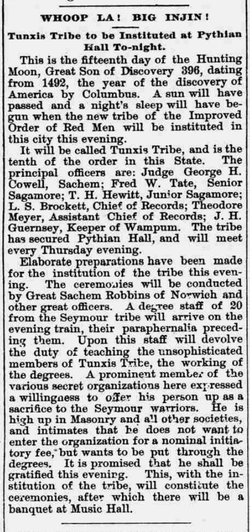Waterbury Native Americans
|
Did You Know?"Redskin" was used as a self-identifier by Native Americans to differentiate between the two races" [Whites and Redskins], for at least 255 years. Source: The History Of 'Redskin'
"50% of people who identified as Indigenous preferred the term American Indian, 37% preferred Native American" - Wiki |
Note: The term "Red Men" is currently in use today by the indigenous Native Americans as the most commonly accepted reference by, and to, themselves. Although the most widely-accepted term is "Red Men", it is sometimes used interchangeably with "Redmen". In either case, the term describes the peoples in totality - men, women, and children alike. By self-exclusion, the Inuit, Yup'ik, and Aleut peoples consider themselves to be Arctic, not Redmen nor any other form of terms which describe the indigenous peoples of sub-Arctics. Educator Resource
Waterbury Native American News ArchiveCity Wide
Ruth Muskrat dedicated decades to Indigenous advocacy. In Waterbury, her national legacy lives on CtPublic; picture, article; 2023.11.06 City Wide
Group in Waterbury hosts first Indigenous People’s Day event WFSB; video, article; 2023.10.09 Centre District
Downtown Neighborhood Red Hawk Nation participates in Waterbury's The Gathering Reddit; article; 2023.09.03 City Wide
Centre District Downtown Neighborhood Waterbury’s Mattatuck Museum returns Indigenous artifact to the Seneca-Cayuga Nation of Oklahoma CtPublic; picture, article; 2022.12.02 City Wide
North End District Unspecified Location Indigenous People's Day (Christopher Columbus Day) Celebrated in Waterbury (the traditional Indigenous People's Day is, of course, Thanksgiving Day) Audacy; extremely brief and incomplete article, laiden with excessive unrelated advertisements; 2023.10.09 Out East
East End Neighborhood 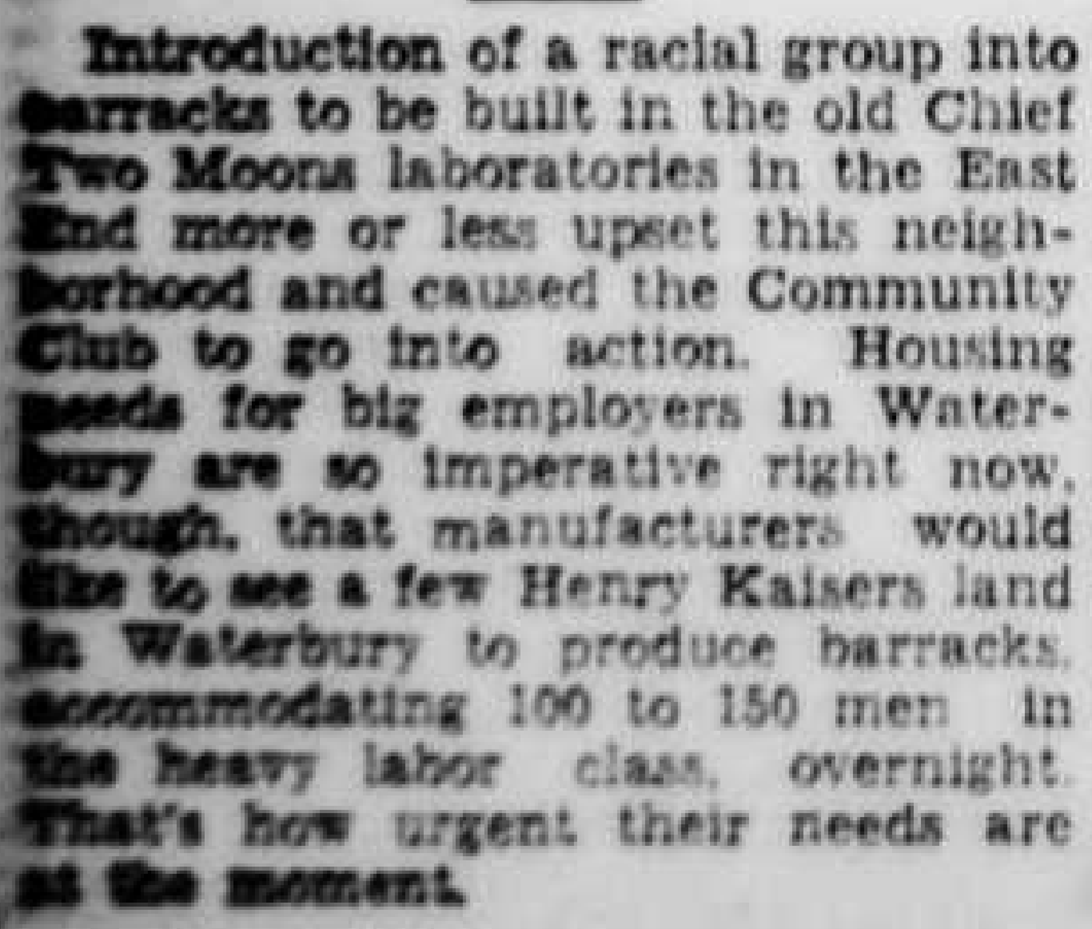
Waterbury Democrat; article; 1943.07.24
Historic
City Wide New Demurrer In Two Moon Case Raises Issue Waterbury Evening Democrat; article; 1932.05.25 Historic
City Wide Tunxis and Toantic tribes, Improved Order of Red Men, held very impressive memorial services in Red Men's hall yesterday afternoon, 125 members being present. The rooms were darkened, and around the camp--fire pole sat the chiefs. They were: Prophet W. II. Benham of Toantic tribe, Prophet C. E. Munger of Toantic tribe, Sachem Kinney of Tunxis tribe, Sachem W. D. Upson of Tunxis tribe, and Senior Sagamores Pretat and Pierce of Tunxis and Toantic tribes, respectively, and Great Sachem Dewitt Preston of Hartford. Appropriate addresses were made and hymns rection of Prof Bartlett An orchestra were sung by St John's choir under di-was also in attendance. The eulogy was delivered by Senior Sagamore Warren L. Hall. The tribes then marched to Rievrside cemetery where fifteen graves of deceased members were decorated. Waterbury Evening Democrat, June 8, 1896 Institute for American Indian Studies
Joins in Local Cultural Tradition "Give Local" Ruth Muskrat Bronson
|
Famous and Influential Native Americans of Waterbury
The Chief Two Moon LegacyWaterbury-born Indian Medicine Man Chief Two Moon
A famous and wealthy Waterburian shown here on his touring bus at the Lincoln Memorial in Washington, District of Columbia in 1925 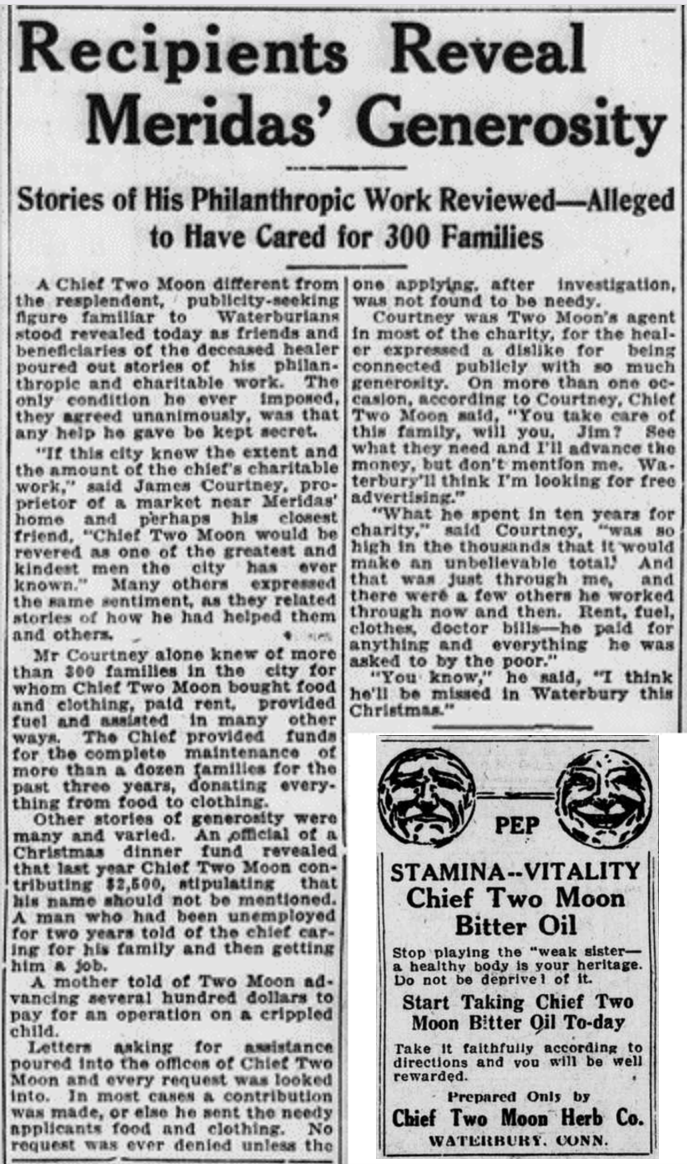
Waterbury Democrat, November 3, 1933
From What Land Did Waterbury Come?
|
|
Waterbury has a long history of baseball, and a litany of team names. For a good part of that history, those names included an affective homage to the Red Men of Waterbury - or, more accurately, pre-Waterbury, although the White Man - Red Man relationship also has a long and robust history until at least the mid-1900s. More on Waterbury Baseball here. |
|
"Indians Are People, Too," which aimed to dispel stereotypes and promote understanding of Native American life, and "The Red Road and Other Narratives of the Dakota Sioux."
American Indian Policy Review Commission: In the 1970s, Ruth Muskrat Bronson served as the only Native American member of the American Indian Policy Review Commission. This commission was established by Congress to evaluate federal policies affecting Native Americans and recommend reforms. Legacy: Ruth Muskrat Bronsons legacy lies in her commitment to bridging cultural gaps and advocating for the rights and recognition of Native American communities. Her writings and speeches continue to be influential in the fields of Native American studies, education, and cultural understanding. Personal Life: Ruth Muskrat married Frederick William Bronson, a journalist and author, in 1921. Bronson himself was born in Waterbury, and is a descendant of the reknowned and history-making |
(Triton is of Canadian Red Man heritage.)
|
Waterbury founding Bronson family of the great Brass City. Together, the Bronsons collaborated on various projects related to Native American issues. Ruth Muskrat Bronson passed away on May 7, 1982, leaving behind a legacy of advocacy and education in the service of Native American communities.
Fitting Burial Place:
Like so many other of Waterbury's founders and elite, Bronson is burried at Riverside Cemetery.
Family
Bronson was 16-years pre-deceased by her husband, John Bronson, and left behind daughters Elizabeth Tidrick, of New Mexico, Dolores (adopted), and at least two other children.
Fitting Burial Place:
Like so many other of Waterbury's founders and elite, Bronson is burried at Riverside Cemetery.
Family
Bronson was 16-years pre-deceased by her husband, John Bronson, and left behind daughters Elizabeth Tidrick, of New Mexico, Dolores (adopted), and at least two other children.
The Tunic Tribe
"In 1892, both the Tunxis Tribe and the Toantick Tribe established an outpost at Waterbury's City Hall." The Toantick Tribe
The Red Men
The Improved Order of Red Men (I.O.R.M.)
Kehow Tribe of Red Men
Former Waterbury Company List
|
The Tunxis Tribe
|
|
Ruth Muskrat Bronson
Ruth Muskrat Bronson Find a Grave Memorial |
Waterbury
American Indian Neighbor-hoods
- Long Hill
- from prior to the existence of Waterbury
- until the early 1900s
- West Side Hill
- from prior to the existence of Waterbury
- until the mid 1800s
Waterbury Native Americans Today
Although some sources indicate that there are close to 700 Native Americans still living in Waterbury today, other sources indicate that there are as few as 155.
Although not known to be of the blood of the more well-known tribes of the predecessors of Waterbury, Takara Hansell, native of Waterbury, carries the blood of the Abenaki Sokoki Missisquoi Tribe. She served on the U.S. Coast Guard and in the U.S. Air Force, according to the social page of the Native American Women Warriors.
Hansell is a well-known dancer in the art of Abenaki dance.
Note: The Vermont Abenaki Artists Association indicate that Hanell is native to Vermont.
Hansell is a well-known dancer in the art of Abenaki dance.
Note: The Vermont Abenaki Artists Association indicate that Hanell is native to Vermont.
The population of Native American Indians in Waterbury is quickly vanishing. There may be slightly over 600 today.
American Indian population in Waterbury
(suburbanstats.org)
American Indian population in Waterbury
(suburbanstats.org)
Waterbury Native American Culture
The Red Men participated, as late as 1931, in the Annual Independence Day Celebration, sponsored by the Bunker Hill Improvement Association (BHIA). In fact, the Red Men won 1st Prize in the men's division that year. Also participating that year was the Red Men tribe's Pequot Club.
Peoples Before Waterbury
Historians recognize that the peoples who lived in the lands that are now Waterbury, Wolcott, Watertown, and others, were the Algonquins, of which there are several sub-tribes.
More information here.
More information here.
Celebrate
Celebrate Native American Heritage Month
(connecticutchildrens.org) October 29th, 2021
(connecticutchildrens.org) October 29th, 2021
Historic Presence of Native Americans in Waterbury
Throughout the 1700s, and beyond, Native Americans are known to have existed in the present day Bucks Hill Neighborhood of the Bucks Hill Section of Waterbury. Specifically, they were known to have gatherings in and near the Wigwam Swamp and the Wigwam River, and to be skilled fishemen.
Native Americans were also known to occupy what is now the Hancock Brook, who were reported to "swoop down" and "torture and carried off" those who ventured into that area, which, seemingly, wasn't yet owned by Mattatuck (Waterbury).
The Native Americans also have historically lived, camped, and fished in what is now the Platts Mills Neighborhood of the South End District.
Native Americans were also known to occupy what is now the Hancock Brook, who were reported to "swoop down" and "torture and carried off" those who ventured into that area, which, seemingly, wasn't yet owned by Mattatuck (Waterbury).
The Native Americans also have historically lived, camped, and fished in what is now the Platts Mills Neighborhood of the South End District.
Glimpse of Early Interaction Betwixt Natives and Anglos
Red Men Organiz-ations
- The Improved Order of Red Men
- The International Order of Red Men
- Kehow Tribe of Red Men
- The Tunic Tribe
- Tunxis Tribe of Red Men
- Schaghticoke Indian Tribe Of Kent Connecticut - Cultural Preservation Project
- (bizapedia.com)
- Although the town of Kent is in the name, this business is registered in Waterbury
Red and White
Peas in a Pod?
Peas in a Pod?
In 1889, the white and red people of Waterbury had such a strong and warm inter-relationship that the Red Men were known to refer to their newly found counter parts as "their white brother".
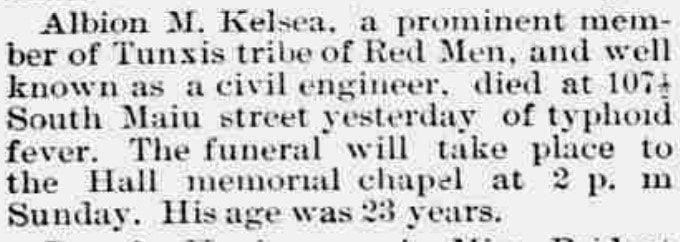
An Irony
"The' great council of the United States of the Improved Order of Red Men has issued an edict forbidding any tribe of the order holding or giving entertainments of any kind where games of chance are permitted, which includes fairs with prize drawings."
Tribes After Waterbury Incorpor-ation
- Kehow
- Toantick
- Tunic
- Tunxis
- Quinnipiac [not known to have been in Matetacoke and may have immigrated to Waterbury circa 1731]
Trading Post
The tribes in Waterbury had a trading post from at least as early as 1891. Among other items at their trading post was their publication "The Indian Trail".
Did You Know?

American Indians are one of the top 7 ethnic groups, along with African-Americans, Alaskan Natives, Asian Americans, Native Hawaiians, Pacific Islanders, and Hispanics when also mixed with any of the above ethnicities, to develop diabetes?
Pushed Out
The Native American Tribes which dominated the area where Waterbury now sits and which ceased to exist at the formation of the plantations, then village, then town, and now city of Waterbury, include:
- Blackfeet
- Crows
- Sioux
"Water-bury",
in Indian
The Native American term for the land upon which Waterbury, and much of the remaining Greater Waterbury, now sits, is Matetacoke. That term may translate to "the interval lands", or "the land without trees", depending on the source. Matetacoke, which included all of the current city of Waterbury, the Borough of Naugatuck, the towns of Prospect, Wolcott, Thomaston, and Middlebury, and Watertown, including Oakville, was purchased from the Tunxis Tribe.
Daughters of Pocahontas
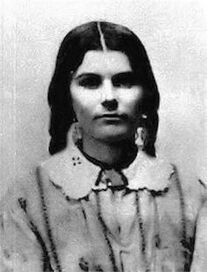
Before the Waterbury Plantations |
Current Presence |
|
The Indigenous Peoples of Waterbury, Connecticut have a rich and complex history that dates back thousands of years. Prior to the arrival of European settlers in the region, the area now known as Waterbury was home to several Native American tribes, including, primarily, the Paugussett, and the Mattabesett, and the Tunxis. These tribes were part of the larger Algonquian-speaking people, who were widely dispersed across the northeastern United States. The indigenous peoples of Waterbury lived in small communities, relying on hunting, fishing, and agriculture for their sustenance. They were semi-nomadic, moving between seasonal camping sites and their principal villages. They also traded with other tribes and engaged in skirmishes with rival groups to protect their territory and resources. When European settlers arrived in the region in the early 1600s, they began to displace the Native American communities and take control of their land. The relationship between the settlers and the indigenous peoples was often fraught with conflict and violence, as the settlers sought to establish their own colonies and exert their control over the land and its resources. Despite these challenges, the indigenous peoples of Waterbury managed to maintain their cultures and traditions, adapting to the changing circumstances brought on by the arrival of the Europeans. They continued to fish in the rivers and hunt in the forests, and they also developed new relationships with the settlers, trading goods and providing guidance on the local flora and fauna. In 1634, the Massachusetts Bay Colony granted a tract of land to a group of settlers, which included what is now Waterbury. The settlers established a town there, and over time, more and more Europeans arrived in the region, leading to further displacement of the indigenous peoples. Despite the challenges posed by the arrival of the settlers, the indigenous peoples of Waterbury continued to resist and maintain their cultures and traditions. They remained resilient in the face of adversity, and they passed their traditions and beliefs on to future generations. In the late 1700s and early 1800s, many Native American communities in the region were forced to move to reservations as the American government sought to assimilate them into white American culture. Despite these efforts, the indigenous peoples of Waterbury refused to give up their traditions and continued to pass them down from generation to generation. Today, many Native American communities in the region continue to celebrate their cultures and traditions, and they play an important role in preserving the history of the indigenous peoples of Waterbury. In conclusion, the history of the indigenous peoples of Waterbury, Connecticut is a rich and complex one that spans thousands of years. Despite the challenges posed by the arrival of European settlers, the indigenous peoples of Waterbury remained resilient and continued to pass on their traditions and cultures to future generations. Today, they play an important role in preserving the history of the region and providing a connection to its rich cultural heritage. |
Today, there is evidence of the Native American cultures of Waterbury, Connecticut in various forms, including cultural events, historical sites, and monuments. Although the indigenous peoples of the area have faced significant challenges over the years, their traditions and cultures have survived and continue to be celebrated by many people.
One way that Native American cultures are celebrated in Waterbury is through events and festivals that commemorate the rich cultural heritage of the area. For example, the city may host events that showcase traditional Native American music, dance, and food. These events provide an opportunity for members of the community to learn about the rich cultural heritage of the area and to connect with the traditions of their ancestors. Another way that Native American cultures are remembered in Waterbury is through historical sites and monuments. For example, there may be monuments or markers that commemorate the contributions of Native American communities to the area. These sites serve as a reminder of the rich cultural heritage of the region and the important role that indigenous peoples have played in shaping its history. In addition, there are likely still members of Native American communities living in the Waterbury area who continue to practice their traditions and cultures. These individuals may be involved in preserving the history and traditions of their communities, and they may also participate in cultural events and activities. Overall, while the indigenous peoples of Waterbury, Connecticut have faced significant challenges over the years, their cultures and traditions have survived and continue to be celebrated by members of the community. Through events, historical sites, and the efforts of individual community members, the rich cultural heritage of the area is being preserved for future generations to enjoy and learn from. |
Other Translations
- Pegasset = Derby
- Pomperang = Woodbury
- Potatuck = Southbury
About the Algonquin CultureThe Tunxis tribe, also known as the Tunxis Indians, were indigenous people who historically inhabited the region now known as Connecticut, including the area around Waterbury. They are part of the Algonquian-speaking Native American group. While specific details about the Tunxis tribe's traditions are not extensively documented, here are some general insights into the traditional customs and lifestyle of many Algonquian-speaking tribes, which may include the Tunxis.
Note: Information about the Tunxis tribe specifically may be limited, as historical records can be incomplete. For a more accurate and detailed understanding of the Tunxis tribe's traditions, it would be beneficial to consult local historical archives, tribal records, or collaborate with indigenous communities in the region. |
About the Algonquin LanguageThe Tunxis people, like many Native American tribes, likely spoke an Algonquian language. The Algonquian language family is one of the most widespread and diverse linguistic groups among the indigenous peoples of North America. Unfortunately, the specific language spoken by the Tunxis tribe is not well-documented, and it might have been a distinct dialect or variation within the broader Algonquian language family.
Algonquian languages are characterized by certain linguistic features, and they share some commonalities across different tribes while also having distinct differences. These languages were traditionally oral, with a strong emphasis on storytelling, oratory, and verbal communication. If there were any surviving records or linguistic studies specifically focused on the Tunxis language, they would provide more detailed insights into its unique characteristics, vocabulary, and grammar. However, due to the limited historical documentation of many Native American languages, especially those of smaller tribes, much of this information may be challenging to access. Efforts to preserve and revitalize indigenous languages are ongoing, and contemporary tribal communities often play a crucial role in these initiatives. If you're interested in learning more about the language of the Tunxis people, reaching out to local indigenous organizations or language revitalization programs might provide additional information or resources. |
Algonquin Affect on Waterbury TodayAlgonquian traditions have had a significant influence on American culture, and some aspects persist in various forms today.
Algonquian people were diverse, encompassing various tribes with distinct traditions. Here are some general influences that can be observed in American culture:
It's essential to approach these influences with sensitivity and respect for the diverse cultures within the Algonquian language family and other Native American groups. Additionally, efforts to recognize and honor indigenous contributions to American culture continue through education, art, and advocacy for indigenous rights and representation. American Indians Are
|
Moses Kills Moses
On December 7, 1771, a Red Man of the Mohegan Tribe, named Moses Paul, while in Bethany, and drunk, swung a flat iron at someone else, missed him, and accidently struck stander-by Moses Cook, of Waterbury, who died of course. History of Connecticut
9 Months later, Moses Paul was hanged for the murder of Moses Cook. Wiki Mohican MarketThe national Mohican Market, started in New London Connecticut in 1896, was one of the most popular markets in Waterbury since 1910, and is the only cash-and-carry market in the Brass City at that time. Originally in Waterbury on West Main Street, the market moved to 16 North Main Street, and remained at that location until at least 1931, and possibly as late as 1946.
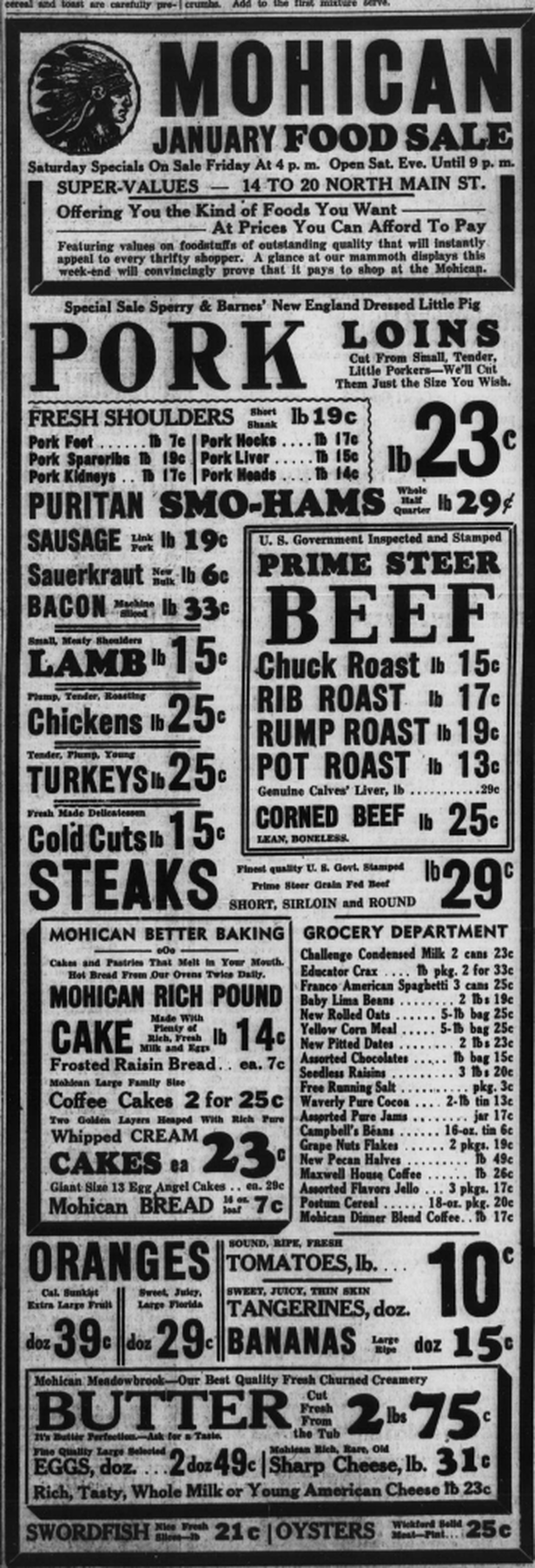
Waterbury Democrat January 24 1936
|
- https://en.wikipedia.org/wiki/Improved_Order_of_Red_Men
- http://redmen.org/redmen/info/
- https://libraryguides.salisbury.edu/c.php?g=1070744&p=7843346
- https://nativeheritageproject.com/2014/09/16/when-redmen-arent-red-men/
- https://tools4racialjustice.net/the-red-men-societies/
- http://www.redmen.org/
- https://libapps.salisbury.edu/nabb-archives/local-history-archives/2015.021
- http://www2.hsp.org/collections/manuscripts/h/Hollis1689.html
- https://en.wikipedia.org/wiki/Native_American_name_controversy
- Griffin, Gail. "Native American History of Waterbury, Connecticut" Waterbury Historical Society; Jones, Lucretia
- "Indigenous Peoples of Connecticut: The Mattatuck Tribe." Connecticut Historical Society
- "Archaeological Investigations of Indian Sites in Connecticut." Bulletin of the Archaeological Society of Connecticut; Banks, Charles E.
- "The Indian Tribes of Connecticut." Bulletin of the Connecticut Historical Society, vol. 17, no. 2, 1952, pp. 43–80.
- "The Indigenous People of the Western Connecticut Highlands." Institute for American Indian Studies
Ransom, David F. "The Archaeology of Connecticut." Yale University Press, 2015.




